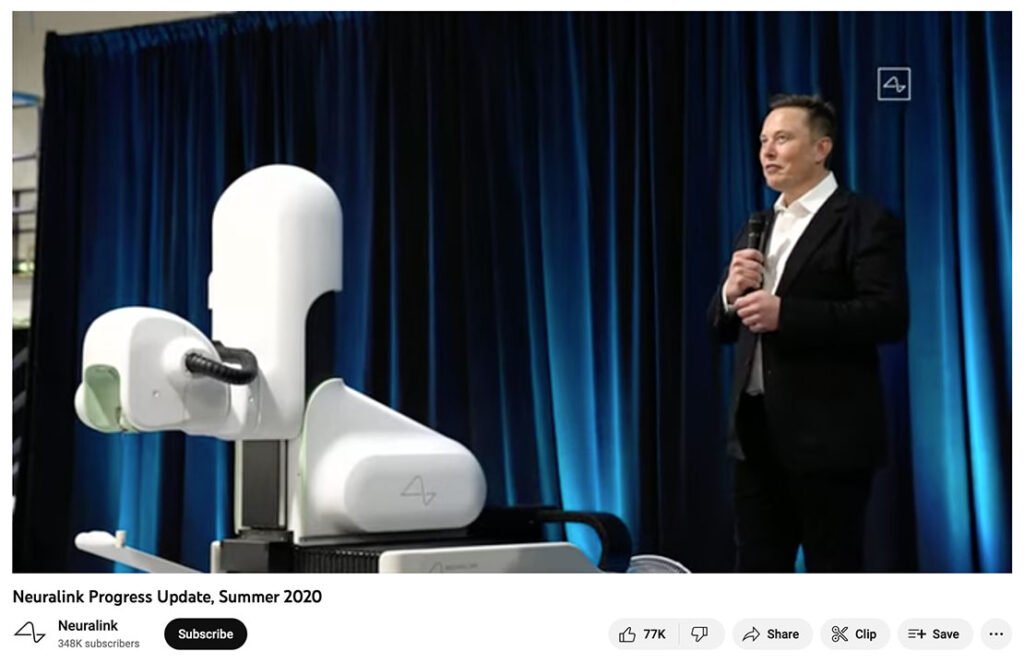Explore the groundbreaking Neuralink startup by Elon Musk, delving into brain-computer interface technology’s revolutionary potential.
KEY TAKEAWAYS
- Neuralink’s Mission: Neuralink, led by Elon Musk, aims to develop advanced brain-computer interface technology with the potential to revolutionize healthcare and human capabilities.
- Wide-Ranging Applications: Brain-computer interfaces have applications beyond medicine, including communication enhancement, sensory restoration, and even the potential to expand human cognition and abilities.
- Ethical and Technical Challenges: While promising, BCIs also raise ethical concerns regarding privacy and consent. Technical challenges and government regulations must be navigated to ensure their safe and responsible use.
In the realm of technological innovation, few names resonate as strongly as Elon Musk’s. Known for pushing the boundaries of what’s possible, Musk has embarked on yet another extraordinary venture with Neuralink, a startup that’s poised to redefine the way you interact with technology and, quite literally, read minds.
Welcome to the exciting world of Elon Musk’s Neuralink startup and the awe-inspiring realm of brain-computer interface technology. In this article, you’ll embark on a captivating journey into the heart of this groundbreaking enterprise, where science fiction meets reality.
Neuralink’s mission is audacious: to bridge the gap between your brains and computers, opening up a realm of possibilities that were once the stuff of dreams. From restoring lost senses to enhancing your cognitive abilities, the potential applications of this technology are boundless.
But as you delve deeper into this cutting-edge frontier, you’ll also explore the ethical and technical challenges that come hand-in-hand with such innovation.
Understanding Brain-Computer Interface Technology
What is a Brain-Computer Interface (BCI)?
In the captivating world of Neuralink and Elon Musk’s visionary pursuits, understanding Brain-Computer Interfaces (BCIs) is pivotal. BCIs represent a remarkable fusion of neurology and technology, offering a direct link between the human brain and external devices. But what exactly is a BCI?
Types of BCIs
BCIs come in various forms, each tailored to specific applications and user needs. These include:
- Invasive BCIs
These BCIs involve the surgical implantation of electrodes or sensors directly into the brain’s neural tissue.
Neuralink’s approach falls under this category, utilizing ultra-thin electrodes, also known as “threads,” to interface with neurons.
- Non-Invasive BCIs
Non-invasive BCIs, like EEG (Electroencephalography), do not require surgical procedures and instead measure brain activity through sensors placed on the scalp.
They are more accessible but typically offer lower resolution compared to invasive BCIs.
- Partially Invasive BCIs
Some BCIs use a combination of invasive and non-invasive elements, offering a compromise between accuracy and invasiveness.
How BCIs Work
At their core, BCIs function by decoding neural signals and translating them into actionable commands or data. Here’s a simplified overview:
- Signal Acquisition: Electrodes or sensors pick up electrical signals generated by neurons in the brain.
- Signal Processing: Sophisticated algorithms process these raw neural signals, filtering out noise and extracting meaningful patterns.
- Command Generation: The processed signals are then translated into commands that can control external devices, such as computers, robotic limbs, or even communication systems.
- Feedback Loop: In some BCIs, there is a feedback loop where users receive sensory feedback from the controlled device, creating a bidirectional communication channel between the brain and the external world.
The Evolution of BCI Technology
Historical Developments
The concept of BCIs dates back to the mid-20th century when researchers first explored the possibilities of directly connecting the brain to machines. Notable historical developments include:
- Electroencephalography (EEG)
EEG, dating back to the 1920s, was one of the earliest forms of BCI technology.
It measures electrical activity on the scalp and has been instrumental in research on brain waves and consciousness.
- Invasive BCIs Emergence
In the 1970s, the first invasive BCIs were developed, primarily for medical research and applications.
They laid the groundwork for future advancements in neuroprosthetics and assistive technologies.
Key Milestones in BCI Research
The journey of BCI technology has been marked by significant milestones:
- Cochlear Implants
In the 1970s, cochlear implants, a type of auditory BCI, allowed the deaf to regain some level of hearing by directly stimulating auditory nerves.
- Brain-Controlled Prosthetics
In the 2000s, breakthroughs in brain-controlled prosthetics enabled amputees to control artificial limbs with their thoughts.
- Neuralink’s Innovation
Neuralink, founded in 2016, represents a quantum leap in BCI technology, pushing the boundaries of what’s possible by developing ultra-precise neural interfaces.
Understanding this evolution is crucial for grasping the significance of Neuralink’s pioneering work, as it builds upon decades of research and innovation in the field of brain-computer interfaces.
The Birth of Neuralink
Inception of Neuralink
To truly appreciate the magnitude of Neuralink’s mission, it’s essential to delve into the inception of this groundbreaking venture. Founded in 2016, Neuralink emerged from the audacious mind of tech mogul Elon Musk.
Elon Musk’s Visionary Ideation
Elon Musk, known for his transformative role in companies like Tesla and SpaceX, has always been driven by a profound desire to tackle humanity’s most pressing challenges. Musk’s passion for space exploration, renewable energy, and transportation innovation led him to contemplate another monumental frontier: the human brain and its interface with technology.
Elon Musk’s Role and Motivation
Elon Musk plays a central role in the Neuralink story, serving as both the founder and a driving force behind the company’s vision. His motivation for diving into the complex world of brain-computer interfaces is rooted in several key factors:
- Advancing Humanity
Musk’s overarching goal with Neuralink is to advance the human species. He envisions BCIs as a means to augment human cognition, revolutionize healthcare, and provide solutions to neurological disorders and injuries.
- Alleviating Suffering
A compassionate aspect of Musk’s motivation lies in his desire to alleviate human suffering. Neuralink seeks to provide hope and help to those who have lost sensory functions or are battling debilitating neurological conditions.
- Bridging the Gap
Musk recognizes the growing symbiosis between humans and technology. He believes that by seamlessly merging your minds with machines, you can bridge the gap between the digital and biological worlds, preparing humanity for the challenges of the future.
- Pioneering the Uncharted
Elon Musk has a penchant for venturing into uncharted territories. His fascination with pushing boundaries is a significant driver behind Neuralink’s ambition to create advanced neurotechnology.
overall, the birth of Neuralink represents a fusion of Musk’s visionary ideation, his commitment to human progress, and his penchant for pioneering the uncharted. Musk’s role as both the founder and motivator underscores the audacity of Neuralink’s mission – to redefine the way you interact with your minds and, in doing so, to change the course of human history.

Photo: Reuters
The Science Behind Neuralink
Neuralink’s journey into the world of brain-computer interface technology is characterized by innovative approaches, cutting-edge neurosurgery, and groundbreaking research. In this section, you’ll delve into the intricacies of Neuralink’s scientific endeavors.
Neuralink’s Innovative Approaches
Neurosurgery and Implantation
One of the cornerstones of Neuralink’s scientific endeavors is its pioneering neurosurgical techniques. The process of implanting electrodes into the brain is a delicate and intricate procedure that Neuralink has refined. Key aspects include:
- Minimally Invasive Surgery
Neuralink’s approach emphasizes minimally invasive surgery techniques, reducing trauma to brain tissue and improving patient safety.
- Precision Targeting
The placement of Neuralink’s ultra-thin electrode threads is highly precise, enabling the interface with specific regions of the brain.
- Biocompatibility
Neuralink focuses on developing materials that are biocompatible, ensuring long-term viability within the brain without causing adverse reactions.
Neural Electrode Technology
At the heart of Neuralink’s technology are its state-of-the-art neural electrodes. These electrodes are designed for optimal performance and safety:
- Flexible and Thin Electrodes
Neuralink’s electrodes are ultra-thin and flexible, reducing the risk of damage to brain tissue and improving the longevity of the implant.
- High Resolution
The electrodes offer high-resolution neural signal recording and stimulation capabilities, enhancing the precision of BCI applications.
- Longevity
Neuralink is committed to developing electrodes that can last for extended periods within the brain, minimizing the need for frequent replacements.
Neuralink’s Research and Breakthroughs
Current Research Areas
Neuralink’s scientific endeavors extend to various research domains, with a focus on pushing the boundaries of BCI technology. Some of the current research areas include:
- Neural Communication
Exploring ways to facilitate direct communication between individuals using BCIs, potentially revolutionizing telepathic communication.
- Neurological Disorders
Investigating applications for BCIs in the treatment of neurological disorders such as epilepsy, Parkinson’s disease, and depression.
- Sensory Restoration
Research methods to restore lost sensory functions, such as hearing or vision, through neural interfaces.
Notable Achievements
Neuralink has achieved several notable milestones in its quest to advance brain-computer interface technology. These achievements include:
- Monkey Mind-Pong
Demonstrating that a monkey equipped with a Neuralink implant could play the video game Pong using only its thoughts, showcasing the potential for BCI-enhanced gaming and communication.
- Human Trials
Initiating human trials for individuals with paralysis, with promising results in enabling communication and control through BCIs.
- Ongoing Research Partnerships
Collaborating with leading institutions and researchers to accelerate the development of BCI technology and explore new frontiers in neuroscientific understanding.
In this exploration of Neuralink’s scientific foundations, it becomes clear that the company’s dedication to innovative neurosurgery, electrode technology, and cutting-edge research is paving the way for a future where brain-computer interfaces play an increasingly transformative role in your lives.
Applications and Potential Impact
Neuralink, Elon Musk’s audacious venture into brain-computer interface technology, holds the promise of transforming not just healthcare but also your everyday lives. In this section, you’ll explore the wide-ranging applications and potential impact of Neuralink’s groundbreaking work.
Medical Applications of Neuralink
Treating Neurological Disorders
One of the most profound applications of Neuralink lies in the realm of healthcare, particularly in the treatment of neurological disorders:
- Parkinson’s Disease
Neuralink’s BCIs offer hope to individuals with Parkinson’s disease by providing precise control over motor functions, potentially alleviating symptoms.
- Epilepsy
BCIs can detect and respond to abnormal neural activity, offering real-time monitoring and intervention for epilepsy patients.
- Paralysis
For individuals with spinal cord injuries or paralysis, Neuralink’s technology may restore mobility and independence by enabling brain-controlled prosthetic devices.
Restoring Sensory Functions
Neuralink’s potential goes beyond treating diseases; it extends to restoring lost sensory functions:
- Vision
BCIs could restore vision to the blind by bypassing damaged visual pathways and transmitting visual information directly to the brain.
- Hearing
Hearing-impaired individuals may regain their auditory senses through neural interfaces that stimulate auditory pathways.
Beyond Medicine: Neuralink in Daily Life
Communication and Control
The impact of Neuralink reaches beyond the medical sphere, with applications that can enhance communication and control:
- Augmented Communication
BCIs could enable direct brain-to-brain communication, revolutionizing how you interact and share information.
- Assistive Technologies
Everyday tasks can become more accessible for individuals with physical limitations as BCIs provide precise control over devices and interfaces.
Enhancing Human Capabilities
Perhaps one of the most intriguing aspects of Neuralink’s potential is its capacity to augment human capabilities:
- Cognitive Enhancement
BCIs may enable cognitive augmentation, enhancing memory, learning, and problem-solving abilities.
- Skill Acquisition
Learning new skills could become more efficient as BCIs facilitate direct brain interface with educational content or expert knowledge.
- Immersive Experiences
BCIs might enable immersive experiences in virtual and augmented reality, offering new dimensions of entertainment and education.
overall, Neuralink’s applications and potential impact are nothing short of transformative. From revolutionizing medical treatments and restoring sensory functions to enhancing everyday communication, control, and human capabilities, Neuralink stands at the forefront of a new era in technology that promises to redefine the way you interact with the world and each other.

Photo: Dado Ruvic
Challenges and Ethical Considerations
As Elon Musk’s Neuralink pushes the boundaries of brain-computer interface (BCI) technology, it confronts a host of challenges and ethical considerations that are integral to the responsible development and deployment of this revolutionary technology. This section will delve into some of the pressing issues.
Ethical Implications of BCIs
Privacy and Security Concerns
BCIs, by their very nature, involve the direct interfacing of technology with the human brain. This raises profound privacy and security concerns:
- Brain Data Privacy
The data collected by BCIs, including neural activity, could be highly personal. Safeguarding this data from unauthorized access and misuse is paramount.
- Vulnerabilities to Hacking
BCIs could potentially be vulnerable to cyberattacks, leading to unauthorized control or manipulation of the devices and, by extension, the individuals connected to them.
Consent and Human Rights
The concept of informed consent takes on new dimensions in the realm of BCIs:
- Consent Clarity
Ensuring individuals fully understand the risks and implications of BCI implantation is essential. Complex consent processes are required to protect individuals’ rights.
- Human Rights Considerations
BCIs have the potential to enhance human capabilities, but they also raise questions about fairness and equality. Access to BCI technology could become a human rights issue.
Technical and Regulatory Challenges
Safety and Reliability
Ensuring the safety and reliability of BCIs is a multifaceted challenge:
- Implantation Risks
The surgical implantation of BCIs carries inherent risks, including infection, tissue damage, or malfunction. Ongoing safety protocols are essential.
- Long-Term Durability
BCIs need to be designed for long-term use within the human body, which requires addressing issues like biocompatibility and electrode degradation.
Government Regulations and Oversight
The rapid advancement of BCIs necessitates clear regulatory frameworks and oversight:
- Regulatory Frameworks
Governments must establish comprehensive regulations to ensure the safety, efficacy, and ethical use of BCIs in medical and non-medical applications.
- Ethical Review Boards
Oversight bodies, such as ethical review boards, should be established to evaluate the ethical implications of BCI research and applications.
overall, while the potential of BCIs to enhance human capabilities and revolutionize healthcare is immense, these innovations also raise complex ethical and technical challenges. Striking the right balance between progress and responsibility is crucial as you navigate this uncharted territory. Neuralink, under the visionary leadership of Elon Musk, must address these challenges head-on to ensure a future where BCIs benefit humanity while respecting individual rights and values.
The Future of Neuralink
What Lies Ahead for Neuralink?
As you peer into the horizon of Elon Musk’s Neuralink startup and its brain-computer interface (BCI) technology, several intriguing questions arise regarding the path forward. This section explores what the future may hold for Neuralink and its groundbreaking endeavors.
Future Research Directions
Neuralink’s commitment to innovation is unwavering, and future research directions are expected to be both ambitious and transformative:
- Enhanced Cognitive Capabilities
Neuralink’s pursuit of cognitive enhancement may lead to the development of BCIs that amplify memory, learning, and problem-solving abilities.
- Expanding Applications
The exploration of new applications beyond healthcare, such as education, entertainment, and communication, could redefine how you interact with technology and each other.
Potential Societal Impacts
The potential societal impacts of Neuralink’s advancements are profound and far-reaching:
- Healthcare Revolution
Neuralink could spearhead a healthcare revolution, offering unprecedented treatments for neurological disorders and injuries, significantly improving quality of life.
- Ethical and Socioeconomic Shifts
Widespread access to BCIs may reshape ethical norms and socioeconomic structures, raising questions about equity, privacy, and human rights.
Critiques and Controversies
Examining Criticisms and Concerns
In the wake of Neuralink’s ambitious pursuits, it has not been without its share of criticisms and concerns:
- Ethical Dilemmas
Critics argue that the potential for misuse of BCIs, such as mind control or surveillance, poses ethical dilemmas that need careful consideration.
- Accessibility and Inequality
Concerns persist about the accessibility of BCIs. Will they be available only to the privileged, exacerbating existing societal inequalities?
Responses from Neuralink and Musk
Neuralink and its founder, Elon Musk, have been proactive in addressing critiques and concerns:
- Ethical Frameworks
Neuralink has expressed commitment to developing ethical frameworks and ensuring responsible BCI use.
- Transparency
Elon Musk has advocated for transparency in BCI development, inviting public discussion and scrutiny.
In the unfolding narrative of Neuralink’s future, it is clear that both the potential for transformative change and the need for responsible stewardship are paramount. As the world watches this pioneering endeavor, the balance between innovation and ethics will undoubtedly play a pivotal role in shaping the course of Neuralink’s journey into the uncharted territories of brain-computer interface technology.
Final Thoughts
In the captivating world of Elon Musk’s Neuralink, the boundaries of possibility are pushed beyond imagination. This audacious startup has embarked on a quest to bridge the gap between the human brain and the digital realm, ushering in an era of mind-bending innovation. From treating neurological disorders and restoring lost senses to the tantalizing prospect of cognitive augmentation, Neuralink promises to rewrite the script of what it means to be human.
Yet, with great power comes great responsibility. As BCIs evolve, ethical dilemmas and privacy concerns loom on the horizon. The path forward is rife with challenges, but the resolve of Neuralink and the visionary leadership of Elon Musk remain undeterred.
One thing is certain: the future of Neuralink holds the key to unlocking human potential in ways you can scarcely fathom. As you stand at the crossroads of technology and humanity, the Neuralink journey reminds us that, in the quest for progress, it is not just the destination but the principles and ethics that guide us that truly matter. Stay tuned for the next chapter in this mesmerizing saga of Neuralink, Elon Musk, and the limitless possibilities of the human mind.






















































Comment Template